- Despite the similar names, the Bronco and the Bronco Sport are very different vehicles
- Here are 10 key differences to keep in mind if you're considering both models
Bronco vs. Bronco Sport: 10 Key Differences
We compare the Bronco and Bronco Sport on performance, off-roading, pricing and more
The Ford Bronco and the Ford Bronco Sport share a nameplate and some exterior styling cues, but underneath, they're very different. Nonetheless, because both SUVs tap into a sense of nostalgia for older Ford products, there's understandably some confusion among shoppers as to what those key differences are. Comparing the Bronco vs. Bronco Sport, we've highlighted 10 different aspects and how you can expect them to impact the ownership experience.
Pricing: Bronco vs. Bronco Sport
If you're looking to pinch pennies, start with the Bronco Sport. Its starting price, in the base trim, is $28,910 (including destination). At the top tier of Bronco Sport trim levels, you'll find trims such as the Badlands. We recently tested a well-equipped Bronco Sport Badlands and the as-tested price came in at $38,445.
The Bronco has two configurations: two-door and four-door. It starts a bit higher at base trim levels, with a starting price of $30,795 (including destination) for the two-door model. The four-door Bronco, in the same base trim level, is priced at $34,945 (with destination). With a full suite of off-roading hardware, the First Edition trim level we tested came in with an as-tested price of $62,605. That's a big difference between the two, and the standard Bronco will have to do a lot to prove its worth.
Exterior dimensions: Bronco vs. Bronco Sport
Worried about parking your Bronco in a tight space? Or whether it will fit in your garage? Well, here are the important numbers. The Bronco Sport measures 172.7 inches in length from bumper to bumper — just over 14 feet. The two-door Bronco is very similar, measuring 173.7 inches in length. The four-door Bronco is considerably longer, at 189.4 inches.
For context, the Bronco Sport is similarly sized to pint-size SUVs like the Honda HR-V (170 inches) and the Subaru Crosstrek (176 inches). Interestingly, the Bronco Sport's Ford Escape platform-mate is roughly 8 inches longer, so if you're looking at the Escape vs. Bronco Sport, it's worth noting that the Escape will take up significantly more of a parking space or your garage. The four-door Bronco, meanwhile, is closer to midsize vehicles like the four-door Jeep Wrangler (188 inches) and the Honda Passport (189 inches).
Powertrains and performance: Bronco vs. Bronco Sport
Both the Bronco and the Bronco Sport offer a choice of two powertrains. The standard engine in a Bronco Sport is a turbocharged 1.5-liter three-cylinder that produces 181 hp and 190 lb-ft of torque. It's not a tower of power, but it's respectable for an SUV of its size. The optional engine is a turbocharged 2.0-liter four-cylinder engine that cranks it way up to 250 hp and 277 lb-ft. During Edmunds' testing, a Bronco Sport with this optional engine went from zero to 60 mph in 7.2 seconds — a good number for its class.
The bigger Bronco gets considerably more power from both its base and optional engine. The base engine is a turbocharged 2.3-liter four-cylinder that makes 300 hp and 325 lb-ft. The optional powertrain is a turbocharged 2.7-liter V6 that puts out 330 hp and 415 lb-ft. During Edmunds' testing, a Bronco with the V6 covered 0-60 mph in just 6.7 seconds. This is an impressive number when you consider the Bronco's size as well as the off-road-oriented tires that were fitted to our test vehicle.
Fuel economy: Bronco vs. Bronco Sport MPG
While the Bronco Sport isn't as powerful as the big Bronco, it can boast much better fuel economy numbers. With the Bronco Sport's base three-cylinder engine, the EPA estimates fuel economy at 26 mpg combined. Upgrade to the 2.0-liter engine and you drop a bit to 23 mpg combined. That's not class-leading, but it's better than any rating you'll get in the big Bronco. Depending on equipment levels and configuration, the non-Sport Bronco ranges from 17 mpg combined on the low end to 21 mpg combined on the high end.
Cargo capacity: Bronco vs. Bronco Sport
As you might expect, the larger vehicle in this head-to-head has more cargo space. The Bronco Sport offers 32.5 cubic feet of cargo space behind the rear seats, which is a bit less than the 38.3 cubes available in the four-door Bronco. The two-door Bronco, however, has significantly less cargo space at 22.4 cubes, so at least the Bronco Sport wins that battle. The Bronco Sport also has some clever small-item storage in the form of a well-organized center console and usable door pockets. The Bronco, however, could use some better storage compartments and more places to put your water bottles or smartphones.
Towing capacity: Bronco vs. Bronco Sport
The big Bronco uses body-on-frame construction, which means that it's essentially a pickup truck underneath. The Bronco Sport has what's called unibody construction, which makes its construction closer to that of a sedan or crossover SUV — in this case, the Escape crossover SUV, on which the Bronco Sport is based.
Not surprisingly, then, towing isn't the Bronco Sport's forte. Its maximum towing capacity is just 2,200 pounds. That is enough to tow a small utility trailer or camper but not much more. The more truck-like Bronco can tow a maximum of 3,500 pounds — a significantly larger load. If 3,500 pounds strikes you as not very much for a body-on-frame SUV, you're generally right, but the Bronco's direct rival, the Jeep Wrangler, operates in the same range of towing capacity. So, for a factory off-roader competing with the Wrangler, the Bronco's towing is where it needs to be.
Interior: Bronco vs. Bronco Sport
With its higher price point and larger footprint, the Bronco predictably has a nicer and more spacious interior than the Bronco Sport. The materials in the Bronco are higher-quality, too, especially on the upper trim levels. Unfortunately, the Bronco's buttons only feel good when you're comparing it to the Bronco Sport.
Up against most other midsize SUVs, the Bronco feels like it was built with a lot of stiff plastic. The Bronco Sport feels a bit plasticky in areas, too, but it more closely matches the small SUV's price point. The Bronco Sport is much quieter on the highway. The standard Bronco's convertible top and hardtop are both seriously loud at highway speeds, with lots of wind noise that can detract from the overall experience.
Technology: Bronco vs. Bronco Sport
Both Bronco SUVs shine in the tech department. The Bronco Sport offers a number of standard features including Apple CarPlay and Android Auto integration along with an 8-inch touchscreen infotainment system. Options like adaptive cruise control and Ford's available navigation system work well in daily practice. There are some low-res graphics in the Bronco Sport, but that's where the Bronco comes in.
The big Bronco similarly gets smartphone integration and an 8-inch touchscreen as standard, but a massive 12-inch screen is optional and it's a pleasure to behold. Screen resolution is excellent and optional driver aids work well. There are also a number of available tech features that can help amateur off-roaders become more confident in the dirt — stuff like Trail one-pedal driving and Trail Turn Assist. One big drawback, though, is that the Bronco's stereo (even the upgraded 10-speaker system) has a hard time battling the wind noise.
Off-road capability: Bronco vs. Bronco Sport
The Bronco Sport can make it to some pretty remote destinations, especially if you opt for one of the off-road-oriented trims, but, no surprise here, it's no match for the big Bronco. The Bronco has significantly more ground clearance, better approach and departure angles, more optional choices for all-terrain tires, a solid front axle and a true four-wheel-drive system with low-range gearing (instead of all-wheel drive). A locking front differential is also available on the big Bronco, and with the manual transmission you get a super short first gear labeled "C" for crawling over serious obstacles with the clutch fully disengaged. Although the Bronco Sport offers a number of significant upgrades for off-roading over the pavement-biased Escape that it's derived from, including a nifty twin-clutch system that can mimic a locking rear differential, it'll never be a purpose-built beast like the Bronco.
Driving impressions: Bronco vs. Bronco Sport
At highway speeds, the Bronco Sport has a nimble attitude. It operates confidently in small openings and feels peppy with the turbocharged 2.0-liter engine. Go with the Badlands trim and you'll have a truly fun dirt-traversing SUV on your hands. Steering is a big letdown, though, with a vague feeling at low speeds. The transmission's shifts are clunky at low speeds, too, making it less fun to commute in than we'd like from a daily driver.
The Bronco's available V6 engine and that engine's mandatory 10-speed automatic (sorry, kids, no manual with the big motor) are an excellent combination. The acceleration is authoritative and the shifts aren't clunky. Naturally, the big Bronco isn't as easy to maneuver in tight spaces, especially with the hefty optional off-road tires. But the steering is well weighted and the highway ride smooth.
Edmunds says
Both the Bronco and the Bronco Sport offer a number of virtues. The Bronco is a highly capable off-roader with impressive driving characteristics for a vehicle that's so competent in the dirt. The Bronco Sport has a plucky attitude and lots of available driver aids that are easy to use. They certainly aren't direct competitors, but they're both worth a closer look.
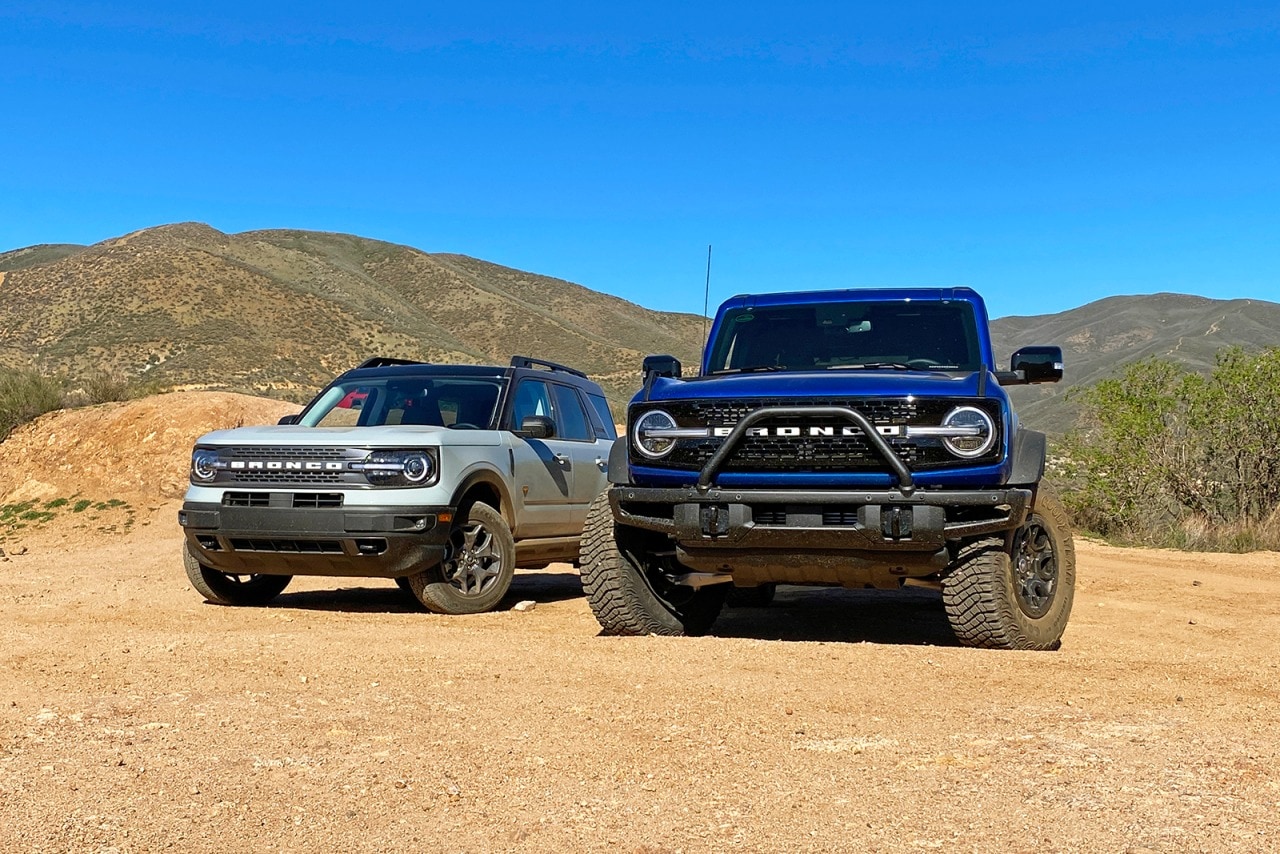
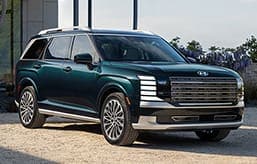
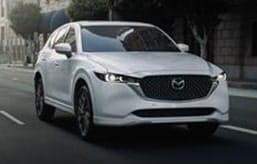
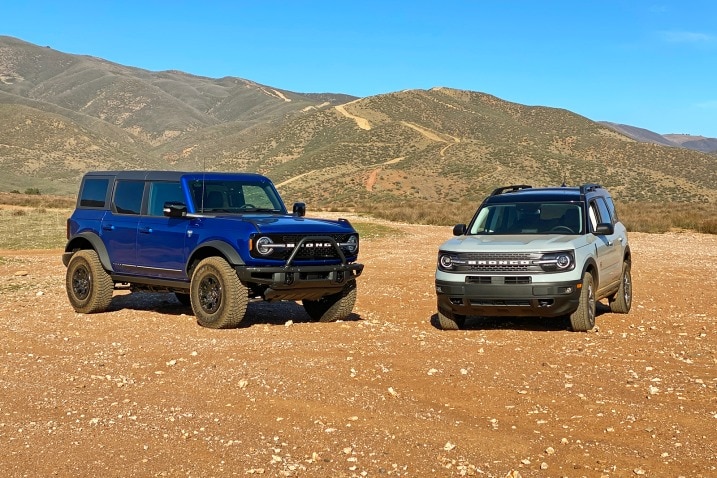

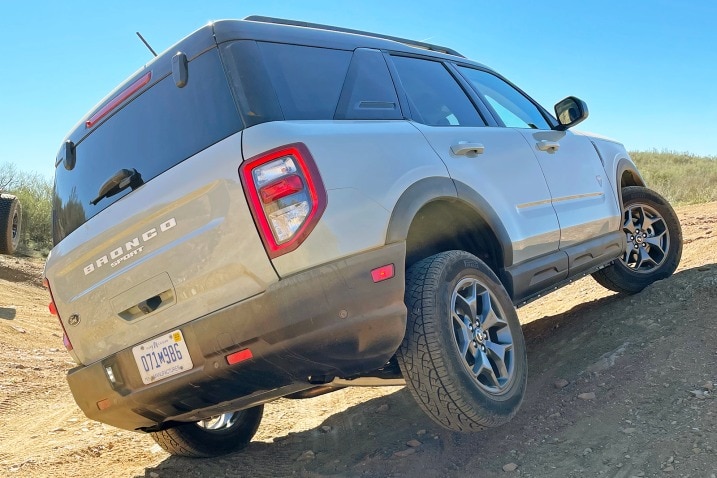
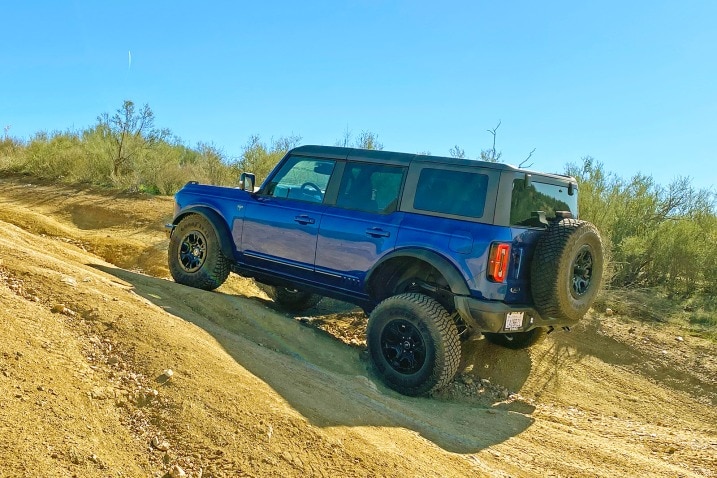

 by
by